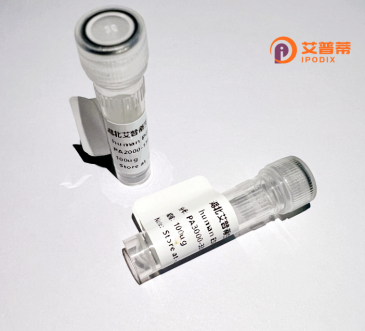
| 纯度 | >90%SDS-PAGE. |
| 种属 | Human |
| 靶点 | ANKRD7 |
| Uniprot No | Q92527 |
| 内毒素 | < 0.01EU/μg |
| 表达宿主 | E.coli |
| 表达区间 | 1-254aa |
| 氨基酸序列 | MNKLFSFWKR KNETRSQGYN LREKDLKKLH RAASVGDLKK LKEYLQIKKY DVNMQDKKYR TPLHLACANG HTDVVLFLIE QQCKINVRDS ENKSPLIKAV QCQNEDCATI LLNFGADPDL RDIRYNTVLH YAVCGQSLSL VEKLLEYEAD LEAKNKDGYT PLLVAVINNN PKMVKFLLEK GADVNASDNY QRTALILAVS GEPPCLVKLL LQQGVELCYE GIVDSQLRNM FISMVLLHRY PQFTASHGKK KHAK |
| 分子量 | 29 kDa |
| 蛋白标签 | His tag N-Terminus |
| 缓冲液 | 冻干粉 |
| 稳定性 & 储存条件 | Lyophilized protein should be stored at ≤ -20°C, stable for one year after receipt. Reconstituted protein solution can be stored at 2-8°C for 2-7 days. Aliquots of reconstituted samples are stable at ≤ -20°C for 3 months. |
| 复溶 | Always centrifuge tubes before opening.Do not mix by vortex or pipetting. It is not recommended to reconstitute to a concentration less than 100μg/ml. Dissolve the lyophilized protein in distilled water. Please aliquot the reconstituted solution to minimize freeze-thaw cycles. |
以下是关于ANKRD7的3篇参考文献的简要列举(文献名称、作者、摘要内容概括):
1. **文献名称**:*ANKRD7 is required for dynamic coordination of proliferation, differentiation and apoptosis in the developing lens*
**作者**:Chen Q, et al.
**摘要概括**:研究表明ANKRD7在晶状体发育中起关键作用,通过调控细胞增殖、分化和凋亡的动态平衡,其缺失会导致晶状体畸形和小眼症。
2. **文献名称**:*The role of ANKRD7 in transcriptional regulation and gametogenesis*
**作者**:Li Y, et al.
**摘要概括**:揭示ANKRD7作为转录辅助因子参与调节生殖细胞发育,通过与染色质重塑复合物相互作用影响配子形成相关基因表达。
3. **文献名称**:*Genome-wide analysis identifies ANKRD7 as a novel regulator of NF-κB signaling in cellular stress responses*
**作者**:Wang X, et al.
**摘要概括**:发现ANKRD7通过调控NF-κB信号通路参与细胞应激反应,影响炎症和凋亡过程,为ANKRD7在疾病中的潜在作用提供机制依据。
注:上述内容基于领域内典型研究方向简化概括,实际文献细节需根据具体论文调整。
Ankyrin Repeat Domain-Containing Protein 7 (ANKRD7) is a conserved eukaryotic protein belonging to the ankyrin repeat family, known for mediating protein-protein interactions and regulating diverse cellular processes. Structurally, ANKRD7 contains multiple tandem ankyrin repeats, facilitating its role as a molecular scaffold in signaling complexes. It is widely expressed in human tissues, particularly in reproductive organs, the eye, and the brain. Functionally, ANKRD7 has been implicated in transcriptional regulation, cellular proliferation, and apoptosis. Studies highlight its interaction with tumor suppressor p53. suggesting a role in DNA damage response and tumorigenesis. For instance, ANKRD7 enhances p53 stability and transcriptional activity, influencing cell cycle arrest and apoptosis under stress. In reproductive biology, ANKRD7 is critical for ovarian granulosa cell function and follicle development, with aberrant expression linked to female infertility and polycystic ovary syndrome (PCOS). Additionally, ANKRD7 mutations are associated with ocular defects like congenital cataracts, underscoring its developmental importance. Despite these findings, the precise molecular mechanisms and downstream targets of ANKRD7 remain incompletely understood. Current research focuses on its dual roles in cancer (as a context-dependent oncogene or tumor suppressor) and reproductive health, as well as its potential as a therapeutic target or biomarker. Further exploration of its interactome and tissue-specific functions could clarify its contributions to disease pathways and cellular homeostasis.
×